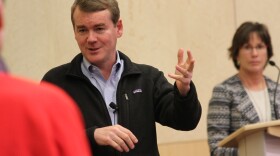The 2017 hurricane season is expected to be slightly higher than average according to atmospheric scientists at Colorado State University.
The annual forecast calls for 13 named storms along the U.S. coastline and two major hurricanes between June 1 and the end of November, when the season ends.
Scientists use a long-term hurricane forecast method which has been honed over 34 years to take into account different weather variables and their outcomes.
“We use historical data and historical relationships. What we find is that there are certain sets of conditions that tend to precede active seasons and conditions that precede inactive seasons,” said Philip Klotzbach, an atmospheric research scientist at CSU and one of the authors of the forecast.
One of those key conditions is an El Niño, or warmer than average ocean temperatures in the tropical Pacific Ocean.
"It just takes one hurricane to make it an active season for you."
Scientists use a buoy system around the equator in the Pacific to relay various real-time weather data, including water temperature. A stronger El Niño can lead to less hurricane activity in the Atlantic, Klotzbach said.
So far in 2017, tropical Pacific Ocean temperatures are slightly warmer than average -- but not quite up to the level of an El Niño.
The warm water changes where intense thunderstorms occur in the Pacific, and affects the wind patterns in the Atlantic, making it more likely that hurricanes will form.

“The Atlantic is also a little bit warmer than normal,” Klotzbach said. “Since hurricanes live off warm ocean water, with the waters being warmer than normal that makes conditions a little more conducive to an active season.”
Florida has the highest risk for a major hurricane at 22 percent.
“Basically what we do is we take those long term probabilities and we adjust them by our latest forecast,” Klotzbach said. "This year, the probability of U.S. major hurricane landfall is at 55 percent, since we're predicting slightly more activity than in a normal season."
Klotzbach said an average hurricane season doesn’t mean weak storms, and even a below average season can still spell trouble.
“You could have a year like 1992 whereDr. Grayput out a perfect forecast of only one major hurricane, it just happened to be Hurricane Andrew which devastated south Florida,” Klotzbach said. “It just takes one hurricane to make it an active season for you.”







